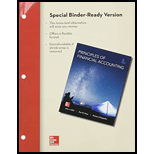
a.
Ascertain the contribution margin per machine hour that each product generates.
a.
Explanation of Solution
Contribution margin:
Contribution margin is a measurement of performance where only revenue and variable costs are taken into consideration. Hence, this measurement is useful in the evaluation of the probable outcomes of decisions including pricing decisions and other marketing strategies that affect primarily revenue and variable costs.
Ascertain the contribution margin of Product R:
Ascertain the contribution margin of Product T:
b.
Indicate the number of units of Product R and Product T that the company should produce if it continues to operate with only one shift, and compute the total contribution margin that this mix would produce each month.
b.
Explanation of Solution
Indicate the number of units of Product R and Product T that the company should produce if it continues to operate with only one shift as follows:
Ascertain the output of Product R:
Ascertain the output of Product T:
From the above calculation it is clear that if the company continues to operate with only one shift, then it would produce a maximum output of 440 units per month of Product R, whereas it would produce only 176 units per month of Product T. Hence the company should produce as much of Product R as possible.
Compute the total contribution margin at recommended sales mix as follows:
c.
Compute the number of units of Product R and Product T that the company should produce, if it adds another shift, and ascertain the total contribution margin that this mix produce would each month, also explain whether the company should add the new shift.
c.
Explanation of Solution
Compute the number of units of Product R and Product T that the company should produce, if it adds another shift as follows:
Ascertain the output of Product R under extra shift:
Ascertain the output of Product T under extra shift:
In this case, the maximum unit sales per month are restricted to 550 units. However, the computed level of output under extra shift exceeds the company’s market constraint of 550 units of Product R per month. Thus the company should produce only 550 units of Product R, and commit the remainder of the productive capacity to Product T.
Working note 1:
| Particulars | Hours | Hours |
| Total hours | 352 hours | |
| Units of Product R (a) | 550 units per month | |
| Hours per unit (b) | 0.4 hours | |
| Hours used for Product R | 220 hours | |
| Hours available for Product T | 132 hours |
Table (1)
Ascertain the total contribution margin that this mix produce would each month as follows:
| Particulars | Units (a) | Contribution per unit (b) | Total |
| Product R | 550 | $40 | $22,000 |
| Product T | 132 | 35 | 4,620 |
| Less: Extra shift costs | 3,250 | ||
| Total contribution margin | $23,370 |
Table (2)
Explain whether the company should add the new shift as follows:
The company should add the new shift, because the contribution margin of extra shift ($23,370) exceeds the contribution margin generated by one shift alone ($17,600).
d.
Describe whether the company should pursue the given strategy and explain whether it is recommendable.
d.
Explanation of Solution
Ascertain the output of Product R under the new strategy:
Ascertain the output of Product T under the new strategy:
In this case, the maximum unit sales per month are extended to 675 units. However, the computed level of output under extra shift exceeds the company’s market constraint of 675 units of Product R per month. Thus the company should produce only 675 units of Product R, and commit the remainder of the productive capacity to Product T.
Working note 2:
| Particulars | Hours | Hours |
| Total hours | 352 hours | |
| Units of Product R (a) | 675 units per month | |
| Hours per unit (b) | 0.4 hours | |
| Hours used for Product R | 270 hours | |
| Hours available for Product T | 82 hours |
Table (3)
Ascertain the total contribution margin that this mix produce would each month as follows:
| Particulars | Units (a) | Contribution per unit (b) | Total |
| Product R | 675 | $40 | $27,000 |
| Product T | 82 | 35 | 2,870 |
| Less: Extra shift costs | 3,250 | ||
| Less: Extra marketing costs | 4,500 | ||
| Total contribution margin | $22,120 |
Table (4)
Explain whether the company should pursue the new strategy as follows:
The company should not pursue the new strategy, because the contribution margin of new strategy ($22,120) is less than the contribution margin of extra shift ($23,370).
Want to see more full solutions like this?
Chapter 25 Solutions
Principles of Financial Accounting, Chapters 1-17 - With Access (Looseleaf)

 AccountingAccountingISBN:9781337272094Author:WARREN, Carl S., Reeve, James M., Duchac, Jonathan E.Publisher:Cengage Learning,
AccountingAccountingISBN:9781337272094Author:WARREN, Carl S., Reeve, James M., Duchac, Jonathan E.Publisher:Cengage Learning, Accounting Information SystemsAccountingISBN:9781337619202Author:Hall, James A.Publisher:Cengage Learning,
Accounting Information SystemsAccountingISBN:9781337619202Author:Hall, James A.Publisher:Cengage Learning, Horngren's Cost Accounting: A Managerial Emphasis...AccountingISBN:9780134475585Author:Srikant M. Datar, Madhav V. RajanPublisher:PEARSON
Horngren's Cost Accounting: A Managerial Emphasis...AccountingISBN:9780134475585Author:Srikant M. Datar, Madhav V. RajanPublisher:PEARSON Intermediate AccountingAccountingISBN:9781259722660Author:J. David Spiceland, Mark W. Nelson, Wayne M ThomasPublisher:McGraw-Hill Education
Intermediate AccountingAccountingISBN:9781259722660Author:J. David Spiceland, Mark W. Nelson, Wayne M ThomasPublisher:McGraw-Hill Education Financial and Managerial AccountingAccountingISBN:9781259726705Author:John J Wild, Ken W. Shaw, Barbara Chiappetta Fundamental Accounting PrinciplesPublisher:McGraw-Hill Education
Financial and Managerial AccountingAccountingISBN:9781259726705Author:John J Wild, Ken W. Shaw, Barbara Chiappetta Fundamental Accounting PrinciplesPublisher:McGraw-Hill Education





